

Dylan Renaud - NanoJapan 2015
New Jersey Institute of Technology
Major: Applied Physics and Applied Mathematics
Class Standing: Freshman
Anticipated Graduation: May 2019
NanoJapan Research Lab: Prof. Keshav Dani, Femtosecond Spectroscopy Group, Okinawa Institute of Science & Technology Graduate University (OIST)
NanoJapan Research Project: Protection of the Optical Properties of Few Layer 2D Phosphane ![]()
Why NanoJapan?
The component of this program that elevates it above others is its seamless assimilation of international STEM collaboration with significant research. The program’s labs employ individuals from an array of different backgrounds working on substantial projects in the fields of nanotechnology, optics, and more. Learning how to work alongside and build relationships with people who are different is an essential skill that applies to nearly every field.
Ever since I was initially exposed to it, I have had a fascination with Japan. In elementary school I tried to cram-teach myself Japanese - it didn’t work out. My older brothers then exposed me to manga, which led me to the clothing, which led me to read up on Japanese historical theater, which led me to garner a lot of overdue fines from keeping books on Japan from the library. When I first read about the NanoJapan program, I applied primarily because I sought to engage with a community that would not only lead me to grow academically, but in terms of life experiences. There are plenty of domestic programs that would have provided me with just head knowledge, but I chose NanoJapan because I would like to pursue more than academics over the summer. NanoJapan allows me to do so.
My goals for this summer are to:
At this point, it has been over a week since arriving in Japan and an enormous amount has already taken place. I’ve met dozens of students, numerous locals, and several professors – I’ve gotten lost in Tokyo, walked through lush forests, seen incredible views, and gone stargazing in a remote village – I’ve made captivating new friends, questioned my own beliefs, and delved deeper into physics…and yet this all still feels far too familiar. My expectations for learning and meeting new people, trying new foods, and seeing new sights have certainly been met. Yet I don’t feel shocked. I don’t feel in awe (there have been moments though!). I don’t feel lost. It feels like home. A recurring thought I’ve had since arriving is the commonality of mankind and how similar this all seems. I’ve often thought about the significance of personal and cultural differences and why they present such a large cleft between individuals and their respective societies. If we really share so much, why do we so very often act in a manner inconsistent with that?
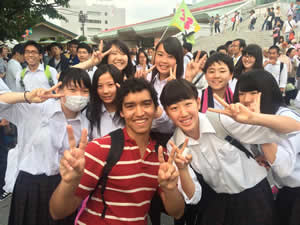
Just me and the homies.
With regards to my language classes I’ve had a fair amount of fun. In all honesty, I’ve been falling behind but I still truly enjoy what I’ve been learning. Speaking to others and trying to understand Japanese has been quite the experience. I’ve loved trying to order food, keep small talk, and just make others laugh while speaking in an entirely new language. Totally unrelated, but as I am writing this, I’ve just experienced my first Japanese earthquake (5.6 magnitude!).
Question of the Week
I can’t say that I have any urgent cultural questions (~ that I haven’t asked. The KIP students have been immediately ready to answer any and all questions). However, something that’s been lingering on my mind is what do Japanese individuals really think about Americans. Throughout the week I’ve been asking KIP and high school students some simple questions: what do you think of Americans and now that you’ve met some is your perception better, worse, or the same? Interestingly enough, I’ve received the same answers over and over – very friendly, honest, talkative, etc. Only one student really dissented and said “diabetes”. It may sound simple, but I’d really like to know what the negatives are and how they can be corrected.
Intro to Nanoscience Seminar
I’ve really enjoyed the bi-weekly intro to NanoScience lectures we’ve been having. With regards to the general theory, I’m familiar with most of the concepts from personal reading. However, the lecturers have done a great job of establishing the interconnect of more obscure ideas with the relevant nanotechnology concepts. While I thought I had a fairly solid knowledge of semiconductor physics, I’ve been able to pick up quite a few new pieces of information and solidify my understanding of the theory surrounding what I already knew.
Initial Research Project Overview
At this point, I have not been provided with any specific details as to what material I will be studying or characterizing. All I’ve been provided with are several papers discussing an array of different semiconductors and novel meta-materials. Furthermore, I haven’t been provided with any details concerning what properties I will be characterizing. I have however been told to understand deterministic dry transfer; a specialized method related to artificially stacking 2D materials (e.g. graphene, hexagonal BN, etc.).
Nagano was incredible. There, along the lush, green mountain side I saw arguably the most beautiful landscape I had ever seen in my life. This was not at all what I had expected. That same morning, I and a KIP student arose early and walked down the mountain, talking about everything from suicide to our siblings. I had made a friend - and not just any friend. I was talking to someone who was literally on the other side of the world just a week ago. Meeting new people has always been something I find exciting. In the past, this has led me to consider how incredible it is that there are over 7 billion individuals with inimitable lives, hopes, and dreams. I will likely never have the opportunity to meet even a thousandth of them. There I was with someone who, statistically speaking, I likely had no probability of meeting a mere week ago.
Excluding that morning, one of my favorite experiences was meeting the rice farmer’s daughter (Unfortunately, I never got her name). This woman was a blast. When I arrived at the patty, she came over, grabbed my hand and gestured to jump into the muddy paddy below. So we did (knocking over the planting legend everyone was using in the process). Next, she began to throw rice stacks, leading up to her tossing Mr. Pibbins (the swamp frog – RIP). Before I left, I asked to take a photo and she quickly became quiet, stepped back, and clasped her hands over her mouth. There was an American tour guide with us and he abruptly declared “The Japanese are shy people man; they’re not used to that.” This experience (ignoring it as a generalization) reflected the idea of Japanese collectivism with regards to social life. I won’t pretend to have any deep understanding of Japanese culture, but by singling her out, perhaps I drew too much attention to her as an individual within that situation. Later that weekend, she showed up at our Japanese barbeque, walked up, and proceeded to show me her new hair extensions.
During my time talking to KIP students, I received a lot of insight with regards to daily life in Japan. One of the most valuable conversations I had however occurred with a Chinese exchange student. We started talking and quickly hit it off, cracking jokes about him being African American and myself being Chinese. The conversation quickly took a more serious turn once we began discussing assimilation into foreign cultures. We ended up talking until he had to leave for an English examination. The whole event really reminded me to pursue meeting as many people as I can during this trip. If you continue to look you can find some real gems.
Preparation for Research Internship
With regards to my research, I’ve been delving deeper into viscoelastic dry stamping. The method initially appeared in a 2013 Dutch paper outlining a way to artificially fabricate heterostructures by stacking 2D materials (e.g. h-BN, MoS2, Graphene, etc.). A large portion of this method’s novelty is attributed to the fact that it bypasses wet-chemistry steps, instead utilizing viscoelastic dry stamping. A simplified description is that the initial sample 2D material is “stamped” by a secondary 2D material forming a heterostructure in the process. The stamp is then peeled off of the newly formed structure leaving behind the two 2D materials.
During our time in Tokyo, we frequently utilized the area’s subway system. As we became more and more accustomed to it we noticed more than a few rigid rules. Instead of listing these one by one, I believe these rules can best be expressed with a single statement:
Don’t exist when using the subway.
Of course it sounds strange, nonsensical even, but this was the sort of behavioral atmosphere that permeated the train cars. No form of talking, eating, singing, or attention-grabbing-action was allowed. The individuals onboard often just stood or sat there, plainly staring at perhaps their window reflection. Having used the New York subway system several times, I can attest to the stark contrast. I’ve been with groups of students who have done handstands while traveling in NY’s cars (of course I would never involve myself in such revelry haha). Here in the Japanese subways a high pitched sneeze is enough to garner a few strange looks. Furthermore, many of the rules of western etiquette are non-existent onboard the cars. It was not uncommon to see several elderly people stand while seats were occupied by the younger generation. Similarly, often times I would turn my head and see someone blankly staring at me. In the U.S., these sorts of behaviors would certainly be frowned upon.
None of this is to say that I viewed these Japanese subway customs negatively. In fact, I would argue the opposite. On more than one occasion I can recall sitting in one of the cars and thinking how much more relaxing it was in comparison with the U.S. From a purely ethnocentric viewpoint however, they were strange. As an American I’ve been raised in a very specific way. The broad U.S. national values centered largely on individualism and achieving specific goals are in stark contrast with Japanese values such as Wa –the Japanese cultural value of harmony and collectivism, Kata – form or very specific behavior done in a rigid, standard way, and Doryoku – demonstration of personal effort is as important as results. Returning to Japanese subways, I think these cultural values are well reflected even in the behavior of individuals riding the subway. Everyone keeps to themselves, making sure to not disturb or disrupt the harmony of the train (Wa). If seating is available, individuals quickly move to occupy those spots regardless of age or gender (Kata). People will publically try hard to get a seat (Doryoku). Okay, that last one was more of a joke but the overall point still stands. Just like in America, the broad, general cultural values Japan are themselves intertwined with the day to day actions of its people.
I believe that the reflection I have done over the last three weeks has truly aided me in processing the internal cultural values I possess. It is quite easy to overlook or bypass the behavioral oddities that exist in our own culture. Once you are able to exist in a culture different from your own you begin to see your own personal nuances for what they are. Furthermore, there I was able to observe a lot of societal differences that were merely practical. Taking off one’s shoes when entering a building, placing money in the “cashier basket”, and not directly tipping food servers are just a few examples of such differences (however, I do miss the ability to freely sing in public).
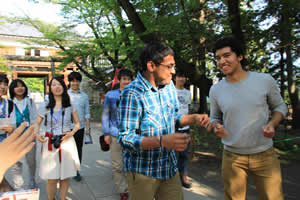
Myself and Ajay-homie-san singing Disney songs for the local students
Intro to Nanoscience Seminar
This week in our NanoScience Lectures we delved further into semiconductor physics, heterostructure fabrication, and the significance of graphene. One of the foundational reasons for nanotechnology development is Moore’s Law. First observed by Gordon Moore in 1965, Moore’s law states that the number of transistors per square inch on an integrated circuit doubles approximately every 2 years. The next question we then may begin to ask is how are nanomaterials and structures fabricated? In general, there are two approaches; top-down or bottom-up. Top-down refers to starting with a bulk material, say a bulk crystal, and by some method such as slicing or milling ending up with nanoscale particles. On the other hand, bottom-up refers to starting with individual atoms and moving up towards nano-sized structures. Regardless of how such nanomaterials are fabricated, some interesting quantum phenomenon begins to become very prominent at the nanoscale, particularly for the case of semiconductor materials. An example of such phenomena for the case of semiconductors is quantum confinement. Quantum dots (type of semiconductor nanocrystal) exhibit band gap tunability by changing their size. This in turn means that one can engineer such crystals to emit certain colors of visible light.
Graphene has attracted quite a bit of interest as a possible replacement material for silicon in nanoelectronics due its attractive electronic properties. It exhibits low electrical resistance (< Ag), high tensile strength (ultimate tensile strength 200x > Steel), visible light absorption < 3% (transparent), and large current carrying capacity. At the same time, Graphene’s absence of an appreciable band gap means its device applications are currently limited. Specifically for the case of graphene transistors, the absence of an appreciable band gap in Graphene means that such transistors can’t be turned “off “, rendering them essentially useless. Despite this, much research is being done to overcome this hurdle by engineering Graphene in the hope of creating an artificial band gap. An example of a way to do this is to dope the material by introducing elemental impurities.
I arrived in Okinawa on June 7th, 2015. Unfortunately, It was Sunday so I stayed in Naha, a city roughly an hour south of the Okinawa Institute for Science and Technology Graduate University (OIST). On Monday morning, I was greeted by an elderly Okinawan gentleman dressed in an Okinawan shirt. He ushered me into the car where another intern was already waiting and drove both of us to OIST. On arrival, Rie-san, a member of OIST’s student support staff, showed us the housing and it more than sufficed. I’m living in a roomy; 3-roomate condo with gold table inlays, Versace bedding, and heated floors.
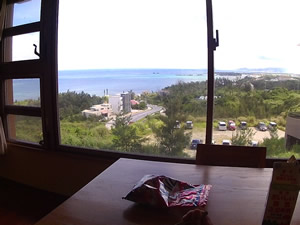
The view from the luxury flat
Okay not quite, but it’s still very nice. Plus, I have a beautiful view in the morning when I wake up. I’m fortunate to have been placed here as several other interns ended up being placed quite a ways off campus. My first day consisted of mere formalities, meeting the support staff, going grocery shopping, etc. I was then told that I wouldn’t be introduced to my lab and professor until the next day, June 9th. So the next morning I awoke bright and early, met Rie-san, and was promptly handed off to another staff member who walked me to my professor’s office. Honestly, during the walk I was quite shocked at just how nice the university’s facilities are (I guess this distracted me from being nervous over meeting Dani-sensei). Once we finally arrived at the office, the staff member knocked on Dani-sensei’s door, smiled, and headed off. This was it, the big reveal. The door opened to reveal a fairly young looking, amicable, casually dressed physicist. I quickly came to realize Dr. Keshav’s large personality, driven demeanor, and penchant for drawing hard work from his students. We talked for a little while and then moved towards figuring out what my project would be. It was during this time that Skylar Deckhoff-Jones, a NanoJapan student from 2014 arrived. Our discussion led to me deciding to partake in two projects (which I will discuss in detail in a bit). While I was not assigned a specific mentor, I was told that if I have questions, there are several people in the group I can talk with. After our meeting Dr. Keshav took me down stairs and introduced me to several of the group members and walked me through their labs – and that was it - It was time to start working. I was introduced to a physics-turned-business MA intern who showed me the basic instrumentation I would be using for my project. I then got to work.
The week had gotten off to quite a great start. I was really enjoying my work, things were moving quite smoothly, I was picking up the instrumentation very quickly and meeting some very cool people, and then tragedy struck. I woke up Friday morning with a bad cough, runny nose, and worst of all – sore throat (I hate sore throats). I emailed my professor telling him I would be unable to come in and decided it was time to take a trip to the OIST health center. Perhaps they could give me some over the counter light weight medicine. Boy was I wrong. They saw my appearance, took my temperature (40 C), and promptly told me I needed to visit a clinic. The only problem was that I had no car and the closest clinic was about 30 minutes away on foot. Just before despair, a hero appeared. Yoko-san, a nurse practitioner at OIST told me that she would drive me to the clinic seeing that I had no other means of getting there. I rushed to my room, retrieved my international traveler’s insurance information, and turned to meet her outside. I hopped into the car and she then told me that the clinic had a wait time of about 110 minutes – totemo warukatta desu. I was in trouble. I was not sure that I could wait that long with the way I felt. She then said “I’ll take you to another clinic with a shorter wait time”. She proceeded to drive me to another location, even further than the initial clinic and kept conversation the entire time. At the clinic’s arrival, she talked with the desk clerk, managed all of my clinical information, and translated as I talked with the doctor. We walked to the patient beds and she even waited with me there. The physician then proceeded to tell me about how physically jacked up I was and prescribed some drugs. We were then sent to a pharmacy where again Yoko-san handled all of the translation and vital information. I was truly taken back by the sheer kindness and care that she showed me throughout the duration of this debacle. During the (long) wait times we talked about an assortment of different things ranging from practicing my Japanese, to her Irish-husband, to laughing about why Japanese babies were cuter than American babies and everything in between.
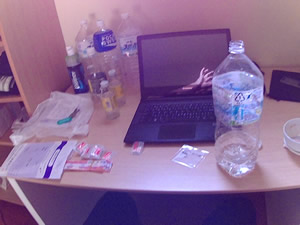
My messy room and Japanese drugs (prescription!)
Overview of Orientation Program
Quite frankly, the orientation program in conjunction with Japan as a whole has been a blast. Since arriving in Okinawa, I’ve been constantly telling stories to the other students here about events that took place during those three weeks in Tokyo and its surrounding areas. I have to say that the most enjoyable part has been interacting with the people of Japan. I could go on and on about hilarious conversations I’ve had, the enthralling stories I’ve been told by KIP students, and the general wonder of Packard-sensei. Specifically however, I’d like to focus on my interactions with the KIP students. With regards to really experiencing Japan and getting to know its people, I have to say that meeting and hanging out with them has really been the most beneficial. There’s nothing that can substitute for making friends across cultures. The experiences that went into that process provided me with a raw, genuine exposure to the people of Japan. I recall during my first week I had several questions that I was continually asking Japanese students. During my final week in Japan, I received a message from one student (not reproduced here to preserve the student’s anonymity) answering the question I had been asking for so long. This sort of personal interaction is something I’ll cherish long after I return home.
The interactions I had with students and individuals such as Packard-Sensei are those that I will truly never forget. Even though at this point I have two more months in Japan, I’m already saddened at the prospect that I will, in all likelihood, never again have this sort of organized engagement with these folk that I’ve come to truly love. I think the most important thing I now know that I didn’t when I first arrived is not something cultural. Rather, it is just how much you can come to care for people who may seem profoundly different from yourself.
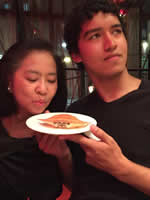
Myself, Packard-sensei, and the crab-homie-kami.
With regards to my language studies I unfortunately do not expect a lot of growth at this point. My lab speaks essentially only English. While I may join OIST’s Japanese club, I don’t expect I’ll have a lot of time to continue my studies in depth.
I’ve been asked to provide three burning questions that I have at this point, but honestly I have none. I’ve done my part when it comes to being inquisitive in Japan. During my stay in Tokyo specifically, I never hesitated to ask a question and that has paid off. Similarly, since arriving at OIST I’ve been constantly asking questions about my research. Another intern from New Jersey joined this week (5th year Grad student). I’ve constantly been asking him questions not really even related to my project, but just about specific concepts in science.
NanoJapan Research Project Update
As far as my research goes however, I love it. When I initially met with Dr. Keshav, I explicitly told him that I did not except to publish a paper during my time here, but that I earnestly desired to be pushed as a researcher. I was then assigned two projects. The first of which the majority of my first week was devoted towards: figuring out how to protect phosphorene. Phosphorene is the Phosphorous equivalent of Graphene. That is to say it is a monolayer of the bulk material, Black Phosphorous (BP). Fabricated by exfoliating BP (an allotrope of Phosphorous), Phosphorene exhibits several fascinating characteristics such as high electron mobility and anisotropic (directionally dependent) electron transport. Unfortunately, it decays under ambient conditions. Specifically, it interacts with oxygen, light, and water in a manner that causes the formation of small topographic protrusions (similar to bubbles). In conjunction with the other members of the Femtosecond unit, I hope to protect the Phosphorene from this form of degradation (I’ll discuss the exact methods in future reports). This project will involve mechanical exfoliation, photoluminescence spectroscopy, Raman spectroscopy, optical microscopy, the usage and handling of semiconductor crystals (InSe, MoS2, h-BN, phosphorene), and viscoelastic dry stamping. At the time of writing this, I have already been trained in using the aforementioned methods and handling the materials.
My second project involves aligning a Terahertz time domain system (TDS) to be used for pump-probe measurements on samples in a fairly large, 17-T magnet. The specific challenge of this project involves the photoconductive antenna (PCA). A quick overview: PCA’s are typically comprised of two metallic spatially separated electrodes on a semiconductor substrate (typically a 3-5 semiconductor, such as GaAs). A bias voltage is then applied across the electrodes and when a polarized pulse strikes the gap, free carriers are generated in the semiconductor and are accelerated by the bias voltage generating terahertz radiation. In this case, the gap is only 5 micrometers across. Aligning the beam will therefore be a challenging but exciting task. This project will involve the use of opto-mechanics and femtosecond lasers.
Flash back to June 24th. We had just finished a great dinner comprised of taco rice, taco burgers, tempura, ramen, melon soda, and more – a truly fulfilling meal. It was approaching 10 p.m. at this point and we decided it was time to head back to OIST to finalize a few things. A few of the individuals in the car with us however needed to be dropped off at Prince Plaza, a residency only a few miles from OIST. As we pulled into the parking lot the car’s occupants began to say their goodbyes and exit the vehicle. With that the incident began. The driver’s passenger side door was abruptly opened and came into contact with the car beside us. At first, no one really thought much of it. After all, it was an accident and there didn’t appear to be damage…at first.
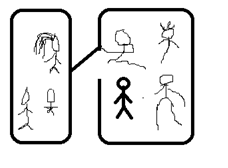
An absolutely true-to-scale depiction of the night’s fateful events. I am represented by the darkened figure.
As the offending individual stepped out of the car and shut the door, I noticed that there was a small girl sitting in the adjacent car’s front seat…and a woman in the back…and a man in the front – a whole family. They all appeared concerned over what had just occurred, and the woman in the back stepped out of the car to see what, if any, damage occurred. There was a scratch noticeable enough that the woman began to call for the person who opened the door. The majority of the occupants of our vehicle stepped out and began to inspect the scratch. Further dialogue ensued when it was determined that the scratched vehicle was being rented by the Japanese family and therefore (it appeared) they were reasonably concerned over incurring fees. The issue here was that no one really knew what the other party was saying. Our group could speak only a very small amount of Japanese (I’m sorry AJALT) and the other family’s English understanding was roughly the same. Individuals from a nearby building came out and became involved. Papers were pulled out, proof of insurance was called for, and driver’s licenses were inspected. The Japanese family wanted our driver’s license along with his international license. This was handed to the Japanese father and he began to walk off towards a convenience store (presumably to scan it). All in all, the situation lasted about 30 minutes and consisted of many words said, little understood, and a large amount of confusion.
I believe our group was earnestly attempting to resolve the situation (we were all tired and wanted to get to our respective homes). The primary problem was that there was an issue with regards to understanding what exactly the other party wanted. In the end, all issues were resolved by simply exchanging information and apologizing. Many times “daijoubu” was exclaimed by the Japanese family (meaning “it’s okay”). Therefore, I do believe we acted in a appropriate manner.
NanoJapan Research Project Overview
Quite a large amount has occurred over the past week. With regards to the Phosphorene project, with the aid of my unit I have been able to test a series of different protection methods including spin coating PMMA and sputtering. At this point, we have had mixed results. While we believe sputtering to be a promising method, steps must be taken to improve the crystal transfer process such that no oxygen or moisture is trapped on the substrate or in the crystal’s region. If this trapping does occur, a photon assisted oxidation reaction takes place once photoluminescence measurements begin. This causes the crystal to continue to degrade rendering the protection useless. Therefore, the crystal transfer process is being moved to a nitrogen filled glove box. We believe that the nitrogen environment will prevent any form of oxygen or moisture from interacting with the black phosphorous. From there, we can use a vacuum box to move the crystal to the sputtering machine.
In addition, our heterostructure set-up has been moved to the glove box. From this point on, my primary working environment will be a fairly small, darkened side room consisting of a glove box and quite a bit of equipment. I’m looking forward to it. Honestly however, I am extremely excited at the prospect of the heterostructure set-up working inside of the glovebox. While next week will not allow me to do any serious work (due to the MTSA conference), I may try to sneak in a few hours to work on the project.
With regards to the TDS set-up, I’ve mainly just familiarized myself with the current set up, checked the beam alignment, and read up on some alignment tricks sent to me by Skylar. If I can find the necessary equipment, I have high hopes that I can get the system aligned within the 2 weeks I have left. After those 2 weeks, a professor from Tulane will be arriving to align the system for use in a 17 T magnet.
Outside of my research I have not been engaging in many activities. Unfortunately, at this point it seems as though doing anything outside of OIST will be a non-trivial task. While I do have an international driver’s license, I’ve found it quite challenging to book a car during times when I am able to explore. There seems to be a large quantity of students booking the vehicles. However, I am proud of being able to drive on the left side of the road without crashing. Initially I was hesitant to drive and nearly destroyed the electric car by driving away from its recharge station without removing the charge nozzle. But after a few minutes and a few screams from the passengers in the back I had mastered it...sort of. This is not to say my time in Okinawa has not come without legitimate challenges. On a more serious note, I’ve found it a bit hard to connect with interns or students outside of my unit. I have not had a large amount of free time and therefore have not been involved in university activities like football, weekly planned excursions, and more. I am a bit concerned that I’m missing out on the cultural aspects of Okinawa as a result. I’ve heard all about the Castle in Naha, purple sweet potatoes, and Okinawan historical sites but at this point I haven’t had the opportunity to really experience any of that.
With regards to my research, I believe I have been progressing quite well. There has even been some talk of a paper resulting from the work we’ve been doing. While I personally feel this may be a bit premature, the more experienced and senior members have high hopes for the work, so I’ll lean towards their expertise and work harder. At this point, I am essentially totally independent with regards to using all of the necessary instrumentation. This week we are setting up the workstation where I will do all of my sample fabrication for the rest of the summer. This is a non-trivial task as we must set everything up inside of a nitrogen filled glove box. We are currently taking the front apart, cleaning the box out, and setting instrumentation up inside. This is expected to take a few days. For the case of the TDS system, I’ve been able to play around with the current system. I’ve worked with the delay stage a bit, corrected minor aspects of its current alignment, and oriented myself with the system’s laser. I haven’t had any real issues with any of the instruments yet. In addition, the lab environment has been very conducive to getting things done. I’ve had no problems with other lab mates or issues related to time-sharing of devices.
Research Project Update
For the phosphorene project I spent the majority of the week making samples of monolayer MoS2 and fabricated a MoS2 on h-BN heterostructure for a paper about to be published by the Dani unit. The time I’m spending making these samples is primarily to prepare me for the phosphorene fabrication steps. I have to say, my project doesn’t seem to be especially challenging. Rather, it seems very time consuming. I typically spend many hours a day searching for correct crystals, building heterostructures, and running Raman and photoluminescence measurements. If I’m able to complete my project in a timely manner, I may have the freedom to construct some interesting devices (such as a black phosphorus/h-bn heterostructure FET) with these crystals and characterize their electrical properties.
“Oh really? You studied Japanese for 3.5 hours every-day for a month? So you know Japanese!”. To date since arriving in Okinawa I’ve heard these words repeated many times. Every time I hear them I become more and more ashamed. My Japanese language skills have regressed more so than I could have expected. While I still often find myself ordering food in Japanese, or asking what I’m eating is, I certainly feel as though I’m losing the language skills I had at the end of my classes. I earnestly feel as though we were well prepared by our instructors during the AJALT language classes. Unfortunately, I haven’t really been required to practice what I’ve studied since arriving in Okinawa. My university speaks English as the official lab language. In fact, English is so pervasive here that I believe I have heard more English since arriving at OIST than Japanese. I recall when I first arrived I began speaking to some of the student support staff (who were all Japanese). I gladly introduced myself in Japanese, began talking a bit about my time in Tokyo, and even asked them a thing or two. I felt as though I could speak the language and it felt great. Unfortunately as my time at OIST has progressed, I’ve become more and more engaged in my research and less and less in the cultural aspects of NanoJapan. I’ve been told on more than one occasion to try to take the language classes they offer here at OIST, but I find myself truly enjoying my project and becoming involved to the point of losing track of time.
The fact that I’ve been regressing linguistically has also resulted in a few awkward situations with the locals. One night, myself and a few lab mates went out to eat. The others ordered, and then the waitress came to me. I looked at the drinks and noticed they were all in Hiragana and Katakana. I was in trouble. She stood there and began to laugh, waited some more, and then pointed at a few things in an effort to describe the drinks. On another occasion I went out with interns and ended up at a snorkeling shop. The elderly couple at the desk had absolutely no idea what I was saying. Finally, on the most infamous occasion (see weekly report #5) a minor car accident resulted in a 30-40 minute effort to trade driver’s licenses and insurance information. All of these incidents have shown me the significance of proper communication and just how important of a tool language is. I’ve thought about continuing my language study of Japanese when I return home and what opportunities, if any, I will have. Because my home institution is a tech-school, language classes are hard to come by. I do think I’ll try to self-study by utilizing the Japanese instruction book purchased for this program.
Turning to the mid-program meeting, I had a blast hanging out with my NanoJapan mates. Unfortunately, my time with them was semi-shortened due to me having to run an experiment with equipment that had to be returned on the Friday they came. Nonetheless, I wanted to show them the highlights of Okinawa that I had experienced up until that point. I ended up taking a few of the guys to Cape Maeda where Anish-san blew out his ear drum and gained the ability to breathe through his ear.
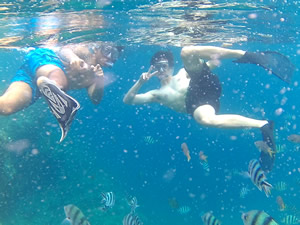
Aaron-san and I leading a school of fish.
Afterwards, I took the group to the “pink-burger-house” (I don’t actually know the real name). Here, Rocco-san consumed arguably the spiciest food in his entire 21 years of living and his reaction was caught on camera. Many tears were shed, mucus began to flow from his nose, and sweat pooled on his forehead. Unfortunately, I was responsible for coercing him into ordering it.
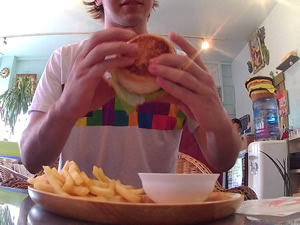
Rocco-san the moment before his life changing decision.
Later that night, the entire group met up and had a great 4th of July Barbecue. Concern began to build up after Anish-san’s injury became public and it was determined he needed to visit a hospital as soon as possible. Therefore, that night he ended up heading to the hospital (see Anish-san’s week 7 report) while the rest of the group headed to karaoke the night away (sorry Anish!).
With regards to my analysis of OIST and the MTSA conference – first off I have and currently am enjoying it all so very much. I’ve really been thinking about how feasible or if I would be able to return to OIST for a longer internship. I have learned far more over these past few weeks at OIST than I have over the entirety of my research at my home institutions. Something that I’ve really loved about OIST is how free I am to work with various instrumentation and perform experiments. In addition, there’s this extremely refreshing atmosphere of collaboration between labs.
Research Project Update
Not much work took place over the past week. While I did not have an extensive period of time to work on my project, I have been able to prepare some very promising samples for characterization of their protection of black phosphorous. In addition, I’m no longer working on the TDS system due to a new professor coming for a week stay to align the system for direct usage in the magnet and because Keshav wants me to focus on this project.
I will start off by stating that I doubt that my analysis of my lab will provide the reader with a real understanding of how Japanese laboratories operate. Regardless, I do think that my experience is one which is wholly unique relative to laboratories in the US (and in fact the rest of the world).
The Okinawa Institute of Science and Technology Graduate University (OIST) is something extraordinary. There are few places in the world as culturally, geographically, and scientifically diverse as OIST. Sprawled out along a mountain top, OIST is a state of the art international graduate university complete with a pioneering group of international researchers and abundant funding to support their efforts. This amalgamation has resulted in something truly special which can be observed even in the minute aspects of daily interactions. For starters, there are really no barriers to interdisciplinary collaboration and interpersonal relations. It’s not uncommon to see a physicist specializing in ultrafast optics talking with an art conservationist or a neuroscientist engaging with a pure mathematician. There are also no hard and fast rules on hierarchy. I was encouraged by my professor to simply call him by his first name. Where in the U.S. (or anywhere else for that matter) is all this common? Disagreement often results in real, challenging conversation and the senior professor is not always correct. I have to say, I truly enjoy this atmosphere as it is so different from anything I have ever encountered. I’ve worked in 2 labs in the U.S. and neither seems to hold in comparison to what I’ve encountered here so far. There seems to be no rules on how one should operate as long as they get the job done. In addition, there are so many tools allowing the students at OIST to do so. I’ve already spent numerous very late nights at my laboratory, staying until the early hours of the morning.
As a result of all of this, my experiences have been vastly different from I was told to expect if I was part of a Japanese laboratory and in some ways this is bad. I know I’m missing out on a once in a lifetime experience by not working at Tokyo U, Sendai, Osaka U, or any other historically Japanese university. I’m glad that the 13 other students get to experience it though. I did have a general idea of what to expect at OIST due to my discussions with my NanoJapan mentors, Skylar and Julianne. I asked both quite a large number of questions and received excellent responses allowing me to be very well prepared.
With regards to my research a large amount has taken place over the past week. I’ve been delving quite deeply into my topic and making a fair amount of measurements. With regards to my phosphorene project I’ve been able to obtain data illustrating processes that have been described in literature, but until now have not actually been obtained by anyone. Furthermore, because my project is dealing with a subject matter that is so new I’ve found myself on more than one occasion prepping to run an experiment and then finding a paper that was just published say last week (or literally while I was running an experiment in one case) outlining the experiment or something similar. This has made my work a challenge and has made this time so enjoyable. In my experience, perhaps the most fun aspect of research is doing something or finding something out that no one else has yet. With this project, I get to do exactly that.
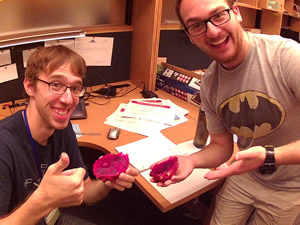
A few of my lab-mate-homies. Pictured on the left is Chris, a very-talented graduate researcher from Rutgers New Brunswick (a university about 20 minutes away from me). I’ve had several engaging conversations with him on everything ranging from quantum mechanics to potatoes. On the right is the chemist of our group, Ari-man. He nearly saved my life on one occasion.
Research Project Update
Over the past week I’ve had a few problems with optimizing the primary device I’ve been using. In addition, I angered one of the university resource managers after asking Skylar to remove an optic that I believed was preventing my measurements from being consistent. I was told by the resource manager not to do it initially, so I worked around it by asking Skylar, a senior member of my unit, to do it (he had much more experience with the device and was given a large range of freedom by the resource manager to make changes with it). I was initially told by Skylar to remind him when I was done with my measurements to put it back in as it could affect the measurements of other users. However, I failed to do so. On Tuesday I walked into the room housing the device to be greeted by the manager sitting down and saying something along the lines of, “You removed the analyzer? The machine now has to be recalibrated and you’ll be in charge of doing so. It really pisses me off when people mess with the equipment I work on.”. For starters, this resource manager is an extremely nice chap. He has tried to help me once in the past with a software glitch I was experiencing. I quickly got out of the room and sat down at my desk. I had screwed up.
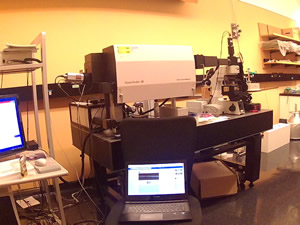
Picture taken at 3 a.m. during measurements. I’ve spent so much time with this device that it’s become part of my family. I’ll dearly miss it along with all of its issues.
I talked with Skylar about this and he insisted that the optic we removed didn’t require any form of recalibration and that in fact all that had to be done was for it to be put back in. I checked the machine, and lo and behold the optic had a set-screw allowing for essentially self-calibration. Later that day after my weekly meeting with Keshav, I met with the resource manager and formally apologized for my actions. We talked for a little while and I described to him that the machine didn’t require calibration. He explained – correctly – from his point of view that my actions were essentially thoughtless towards other researchers using the instrument. I had removed and not replaced an optic that would affect the measurements of other users without them knowing what was wrong. Honestly, this was my initial concern when I first had it removed, but I essentially got lazy and forgot to replace it. I then asked him for permission to open up the machine and remove the optic myself whenever I needed to run measurements. He obliged under the condition that I replace it every time.
Taka – post doc at OIST in Dani Unit:
Q. What is your degree and why did you decide to study (that field)?
A. I went to high school in japan 10 years ago. I didn’t really like it so I moved to Australia and finished high school and went to undergrad and got my PHD. Along the way I enjoyed the research in chemistry in combination with lasers and physics.
Q. Why didn’t you like studying in Japan?
A. I was taking science courses in Japan, but it is pretty common to study everything other than science (there). I just wanted to focus on science. I did a bit of biology and femtosecond lasers science.
Q. So how did you end up here at OIST?
A. About 2 years ago I did an internship In the femtosecond unit at OIST. I enjoyed the terahertz spectroscopy. He called me back after finishing my PHD
Q. Have you studied in the U.S.?
A. No I haven’t.
Q. Have you studied in any rigorous Japanese labs?
A. (Laughs) No I haven’t. I learned science or research in English so there are lots of words that I don’t understand in Japanese.
Q. Do you think you have an idea of how Japanese labs operate?
A. Kind of, yes.
Q. Can you compare them to western laboratories?
A. I feel the western laboratories have a bit more independence. In Japan they are basically taking over what has been done from the previous students or post docs and there is not much originality. They just carry on research. In terms of supervisors, the professor has some associate professor and that kind of hierarchy is common in Japan. In western labs I think each supervisor has one research group and on research topic. I think that is a huge difference.
Q. Which system do you prefer?
A. I think both have good point and bad points. The hierarchy system is bad because is it very hard to become a professor but also you get the support from the professors so that is a good thing. For the westerners you have your own research so you can do whatever you want to do but you also have to take risk like as a young researcher having funding and attracting students. It is just a process to become famous – it is tough.
Q. How hard is it to become a professor in Japan?
A. It is very hard. It is common they switch to university and like head hunting.
Q. Okay. Has your international experiences solely been with regards to Australia?
A. Yes…well my girlfriend is from Hong-Kong so I---
Q. Haha, We’ll get back to your girlfriend later. How was your international lab experience (in Australia)?
A. In my previous university there were some international visitors (researchers) – mainly from China. My friend is from China. He’s pretty smart and a good person. He works hard as well. It is common in Australia they have a lot of half-orders. They’re background is slightly different.
Q. So they’re not so Australian you’re saying?
A. Some have Italian background.
Q. Do you believe that the internationalization of your research experience has impacted your research, if at all?
A. I think it is good to have- For people from different countries they have different thoughts and ways to think about things. I think that is a good thing. It is pretty common the Japanese don’t speak out what they are thinking in their hearts. I think it is good to have a mixture of different cultures.
Q. I had another question – from my perspective it is not often you hear of research coming from Japanese universities. Do you feel the Japanese don’t publicize their research well?
A. No, I don’t think that. Sometimes I doubt their really wordy presentations though, haha. There are TV shows and programs where they interview researchers or on entertainment TV shows. It is not that closed.
Q. Are you aware of any famous U.S. professors?
A. (Pause)…there is a professor I was looking at. He is Greg Scholes. He was from Canada but he recently moved to Princeton (NJ). He does ultrafast spectroscopy and 2D spectroscopy, something I’m interested in.
Q. So you’re looking to go to Princeton?
A. Haha, that might be tough. Usual spectroscopy is signal and wavelength. But you have another dimension that separates this overlap of the normal spectra.
Q. Okay. What do you think is the most significant difference between Japanese research and Australian research (or Western research)?
A. I never thought of it that way. In Japan now we are having better funding for researchers. They have good motivations to applications. In Australia the research is still unique, but the funding is getting worse. In the university, the focus is primarily teaching. There are still good researchers though.
Q. Do you want to pursue Academia/teaching?
I like teaching.
Q. What would be Taka’s dream future?
A. Becoming a big time professor or to become big in Academia. I prefer to stay in U.K., Australia, Sweden (laughs). Japan is not my number one. The U.S. is good too. It is in the group (with U.K., Australia, Germany, etc.)
Q. So you mentioned that your girlfriend is in Hong Kong?
A. She is in Hong Kong, yes.
Q. What do you think has been the most significant thing or person with regards to your research/scientific career?
A. I would say my previous academic supervisor in Australia. He advised me a lot and in a lot of personal issues. He helped me a lot the last few years.
Q. So when you broke up with your girlfriend, and you were really heartbroken, he was the one who consoled you (laughs)?
A. (Laughs) I guess so (laughs).
Q. Really!?
A. (Laughs) Maybe.
Q. How old was Taka when he had his first girlfriend?
A. I was 14 or so (laughs). It was just like to become 1 step closer than just friends(laughs).
Q. So the goal of this relationship was marriage, right? At 14?
A. Uh no, no - I don’t think I was thinking that far ahead (laughs).
Q. So with regards to your romantic relationships, are you ready to settle down and have a family?
A. (inaudible) (laughs).
Q. How do you feel your scientific career will impact your ability to settle down and have a family?
A. Usually the . It is a bit hard to have a family. You have to think about giving up academia and working as a technician or another stable job.
Q. So not being a professor in Academia will greatly affect your family life decisions?
A. (Inaudible)
Q. So how long have you been with your current girlfriend?
A. 5 years.
Q. Long time..
A. Yeah we did Ph.D together in Australia. We help each other and write manuscripts (publications).
Q. In your Honest opinion, how do you view the U.S. or Americans?
A. I don’t know much. I only know they like suing people. I haven’t heard that many bad things.
Q. (Long pause) Do you have anything you want to say?
A. Yes, Dylan is working very hard and staying very late (laughs).
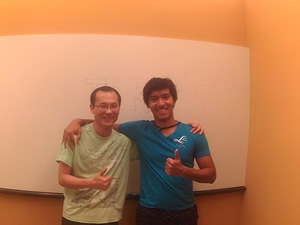
Taka-homie and I. Best Japanese interviewee I’ve ever had.
Research Project Update
While I had several data sets depicting the protection of the crystal (BP) for approximately a week, the crystal’s PL signal was behaving in a very odd manner. A significant and monotonic blue shift of the crystal’s peak PL position has been occurring with respect to time. At the same time, the crystal’s peak signal remains the same or increases indicating that the crystals are not degrading in a manner wholly consistent with degradation under ambient conditions. I’ve talked with other members of the unit and a few of us spent an hour or so shooting ideas off of each other. Regardless, because of this blueshift Keshav was not satisfied with any of the data I had collected. In addition, due to a few issues with one of the devices I’m using the consistency of my data has come into question. Therefore, he wants me to make more samples and obtain data that is reliable. I completely understand this and am up for the task.
Because these measurements shouldn’t take too much time, I want to try and enhance other properties of the crystal. A few ideas have been discussed during my weekly meeting with Dani. Skylar brought up a potentially great idea and now I’m moving on to creating more complex crystal structures. Most of my concerns with my project are with regards to whether or not I will be able to explore/try the ideas that I have for the project before I leave. I’m starting to keep a record of a few things, and if I’m unable to complete them before I leave I hope to hand those ideas over to one of the post-docs to see if he’s interested in pursuing them further.
After reading about the Obokata controversy and the associated papers I was struck by two things:
One of the articles I read outlined a few of the current issues in scientific research. This article, entitled “Challenges in Irreproducible Results”, outlined that fraud or the absence of reproducibility is quite common amongst the scientific community. The article stated that due to the pressure and intense competition to bolster one’s scientific statues, researchers are often driven to manipulating data to fit their expectations or outright presenting fraudulent information. While this is certainly inexcusable, I was far more shocked at the article’s later claim. The article went through more than 40 of the premier scientific papers over the past 50 years and tried to reproduce the paper’s results. Out of those 40 or so publications, the group was only able to reproduce 6. Now, it is understandable that the group may have been limited due to available instrumentation, but this sort of discrepancy between “premier science” and reality seems tremendously dim. I was homeschooled up until entering college and even though my mother had no scientific degree*, I can recall constantly being urged to reproduce my scientific results. In 6th grade I did a project on soil porosity. I hated this experiment due to the fact that I had to reproduce it numerous times at the urging of my mother. In high-school I did research at the New Jersey Institute of Technology. There, my advisor had me reproduce one portion of my project over 15 times to demonstrate to him that a particular process was occurring. During my freshman year of college, I took an experimental research course where my professor again urged reproducing results. I state all this to emphasize that I believe that the reproducibility of one’s results is a norm and the basis for scientific discovery. The absence of it seems to undermine the purpose of science. How can any researcher make any conclusion concerning his data without having his results be reproducible?
I don’t know that this incident could have come at a worse time for Japan. Taking into account the fact that currently Japan is attempting to increase female participation in the sciences, this sort of revelation does much damage to Japan’s initiative. Reading about her troubles with maintaining data and experimental parameters made me nervous. At the beginning of my time here at the Dani unit I was very, let us say, “lax” about how I kept my notes (sloppy as sloppy can be). At one point, one of my data sets had to be excluded because I didn’t write down enough about the parameters. So I understand how one can make mistakes. As my research developed however, I began to realize how significant it was that I wrote down my notes in greater detail. I began writing down the day and which samples I was analyzing in conjunction with the configuration I was using. Then in the data folders on the computer I would keep a text file that had in detail notes about which optics I was using, my thoughts about the experiment, and whether or not there were issues during measurements. The fact that she was a head of a lab and failed to do this seems quite alarming. It also reminds me that I need to be extra pre-cautious when maintaining data. These sorts of foundational aspects of research are vital for scientific success.
With regards to gender issues in Japan in both Japanese culture and research, I can’t say that I’ve noticed too many differences between American and Japan. Both countries seem to be doing quite a lot to tackle observed gender inequality. At OIST, there is an active board tackling this issue in research. While walking through the hallways I will often see signs or pictures encouraging women in research. In my own unit there are two women - Jinjing and Elaine - and both are contributing to the unit as a whole in the same manner as their male counterparts.
Research Project Update
I’ve obtained the data that Keshav wanted and he seems pleased. This protection method can now be used by the Ph.D student who is coming in after me to do (potentially) his thesis on black phosphorus. Last week, Keshav had asked what needed to be done next to start writing up a paper, and the crystal enhancement suggested by Skylar (see week 9) was brought up. I spent the entire week making 15-20 samples using this method and none of them seemed to work. This is where it gets exciting.
There have been a few theoretical publications coming out over the past weeks stating that black phosphorus has a metallic phase and discussing how to transition into this phase. The samples that I made all had a curious lack of a PL signal. This may be attributed to three things which I won’t go into detail on here. I went out to breakfast with two of my lab mates on Saturday and was talking with them about this. I brought up the absence of a PL signal and one of the other lab mates reminded me that I had told him about the metallic transition being a possibility a while ago when I first started making these samples. He then mentioned that perhaps, after making this many samples and seeing no PL signal, this is what I am observing. I asked about taking hall measurements, but the other lab mate mentioned that he was just trained in laying down gold electrodes via nano-fabrication techniques (e-bam, photo litho., etc.). We discussed the possibility of taking I-V measurements which might (while perhaps not conclusively) show us if a transition is occurring. That same day, we rushed back to the lab and myself and Ari (the second lab mate) began fabricating the device. At this point, the device has not been finished so I can’t state any results. While we were in the clean room fabricating the device I noticed just how incredible the nano-fabrication techniques available here at OIST are. I now have another idea for making a device but am not sure about it due to the lack of time.
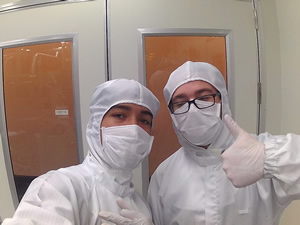
Ari-homie and I in the clean room prepping
Also, this week I slightly modified the Raman machine (I had permission this time!) by putting in some optics to due polarization measurements. I wanted to verify that I had set up the system correctly, so using the samples that I had made I began to take Raman measurements. As I was observing the three peaks, I noticed some odd behavior dependent on the number of layers and related to the peak ratio of one of the in-plane and the out-of-plane vibrational modes. I read a paper that mentioned a component of this behavior for thick layers, but no sources outlined this peak ratio layer dependency in quite the same manner that I was observing it. This gave me a crystal thickness characterization idea and I wanted to look just a little further into this, but at this point it’s just a tangent that may or may not actually be interesting. In addition, the measurements that I would need to take to verify this idea would require me to make many more samples and learn to use a new (and not simple) instrument. With my limited time left, I’m more excited about the other ideas and therefore will pass on this for now.
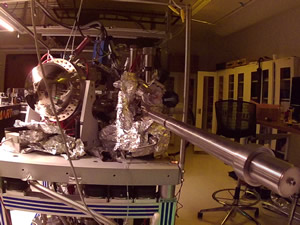
LEEM/PEEM system.
In my meeting with Keshav today, many members of the unit came and began to discuss other ways we could figure out what was taking place with the samples. Our group has an amazing researcher, Michael Man, who specializes in low energy electron microscopy and photoemission electron microscopy (LEEM/PEEM). The second component of this powerful tool (PEEM) allows determination of band structure. Therefore, the suggestion was made that I make another sample for him to analyze and he will be able to determine if changes correlated with a metal transition are occurring.
This is getting quite fun.
First and foremost, I think my perception of Japan as a nation and of the Japanese people has changed. This is not to say that before coming I had a concrete idea of what Japan was or who its people were, but I had a more than a few preconceived notions. To compare my perceptions prior to arriving with my perceptions now I think I first must explain the factors that changed my views.
The first factor was most definitely the people. Starting with Packard-sensei, I’m very fascinated with how good-humored the Japanese are. I can recount time after time where I had just met a Japanese student/researcher/person etc. and we almost immediately started joking around and laughing with each other. Before I came, I think my views towards the people of Japan were that they were these sorts of hard-nosed and inflexible individuals who were bound by rigid cultural standards of etiquette. I think this belief was also bolstered by the pre-orientation material provided to the NanoJapan students before departing for Japan. A common theme throughout the material was that the Japanese were these extremely focused, work oriented people who if they weren’t working were trying to make it appear as if they were. The only time the Japanese could practice or demonstrate their individuality was when they went out drinking. In turn, I thought that my interactions with the Japanese would be largely dictated by a laundry list of introductory procedures and self-conscious dialogue and that if I didn’t follow it all to the tee I might come across as rude or even worse – not have the opportunity to converse with them (I know, it sounds like I thought of them as robots). Fortunately, this turned out to be far from the truth. For example, I found myself greeting individuals and being greeted in an array of different ways. Sometimes it was a bow, sometimes an enthusiastic “Hajimemashite”, other times a handshake, and once in a while a simple smile. This very practical example serves to illustrate that my relations with the Japanese were far different from what I had been prepared to expect. My views towards the Japanese now well reflect my personal experiences.
The second factor was the land. Nowhere in my entire life have I ever experienced something comparable to the distinct architecture and land variety found in Japan. I think this is largely due to the compact cubic structure of most buildings, but nonetheless, the buildings that I lived in and saw were unlike anything I had ever experienced. Even in Okinawa (which some may argue is not Japan), the architecture was something wholly unique to me. While the designs may be a facet of modern Eastern architecture, I was nonetheless radically shocked at the appearance of buildings when I first arrived. I can still recall getting off of the bus when I first arrived at Azabu-Juban and talking with Steven-san about how amazing the buildings were. Furthermore, the variety of the landscapes was also charming. Literal mountains were surrounded by metropolitan and modern neighborhoods at Fuji. In Okinawa, OIST – by all means a technological wonder – overlooked the East China Sea and its constantly changing hues of blue. While I didn’t think much about the landscape and architecture before arriving, I certainly think my idea of a Japan as a land was along the lines of imperial looking buildings and primarily forests. Regardless, my perception of Japan’s landscape has been greatly altered.
The final factor was the culture and customs. America certainly has its fair share of national holidays. Independence Day, Memorial Day, Presidents Day, etc. But Japan takes this to an entirely new level. The holidays I briefly learned about were truly involved occasions. Large scale festivals and events were routinely executed. In Okinawa, there seemed to always be some cultural event taking place. There just seems to be a well-grounded connection between the Japanese people and their heritage. They know where they come from, how those before them have shaped them, and how to celebrate them.
If anything, I think my experience in Japan has caused me to be to evaluate the U.S. in a bit more critical light. The largest difference between the U.S. and Japan seems to revolve around the people. The people of Japan seem to be far more homogeneous in their views on economics, social matters, and more. While this certainly may be due to the fact that the Japanese population is roughly half of the U.S., it was fairly refreshing to experience this. There seemed to be this notion that if you said something that differed politically with the person in front of you no bitterness or dissension would come from it (this might be due to the fact that the Japanese don’t seem to really express personal views in public and are, generally speaking, quite collectivist). The conversations on controversial matters that I had with Japanese students didn’t seem to be practicing walking on eggshells. I really wish I could constantly experience this sort of civility in conversations back in the U.S.
Personally, my experience in Japan has greatly altered my attitude towards the future of my life. This trip was the first time I had ever left the U.S. Consequently I was pretty much barraged with new experiences. Whether it be going through immigration or correctly entering a shrine, the sheer variety of things that I experienced has greatly made me long for more. Before leaving, I really didn’t think much of traveling. However, there’s something about living your entire life in essentially the same town (occasionally visiting another state) that causes you to be quite bored upon returning from a 3 month international trip. I don’t want to be cliché about the idea of traveling however. I don’t want to travel for the sake of going somewhere else and saying I’ve done it, rather I’d like to be purposeful about it. I’ve already begun thinking about foreign research groups within my current field of interest and the feasibility of internships with those groups. Therefore, I think this trip has altered my attitude towards my future academic and professional endeavors.
I also think that my slightly critical attitude towards the U.S. now is due to the fact that I didn’t really experience any sort of frustrations while in Japan. Sure, every now and then it would have been nice to have been able to understand what the cashier across the counter was saying or what the girls we met atop Cape Maeda were asking, but these are really minor things that could be corrected if I had taken language classes a bit more seriously. All in all, my experience in Japan was nearly perfect. I think this largely contributes to my desire to return there.
Above all else however I will sincerely miss two things: the people and the independence. Never in my life have I met people kinder than those I met in Okinawa. See my weekly report 4 for an example of what I mean by this. Perhaps it was due to the fact that I was a foreigner in their land, I nonetheless felt extremely welcomed and comfortable getting to know and work with the Japanese and others in my laboratory. Specifically at OIST, I really believe my experiences with the people there this summer was a once in a lifetime and I will sorely miss them.
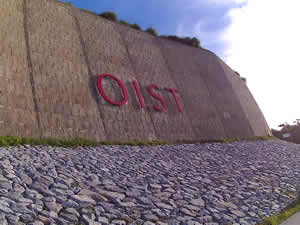
OIST.
Another thing that I really was addicted to was the independence that came along with the entire adventure in Japan. I can recall in early June being dropped off at Haneda Airport in Tokyo to head to Okinawa and realizing that this was about to be the first of many events in my life. It was my first time truly flying along, my first time alone abroad, my first time getting a hotel alone, and my first time simply figuring out how to get around in an unknown place. I enjoyed it very, very thoroughly. I think it really goes back to the feeling of excitement we get as young children (I guess I’m still a child relatively speaking, 19 ain’t that old). As children it was always so easy to encounter new experiences and there was a certain thrill that came along with them. Figuring out what that button does or exploring a new creek behind the neighborhood was exciting, it was new, it was refreshing. As we get older that excitement is worn out by experience. We press that button over and over again and obtain the same result. We visit that creek week after week and see the same fish. Traveling to a new country reignites that exploratory desire. The independence that I had in Japan allowed me to reignite that spark time after time.
Turning back to the research for a moment, this entire experience has greatly altered my attitude towards academic research and my research interests. Before arriving, my research experiences had been far from the best. I had spent the last half year in a hydrogen fuel cell lab. I wasn’t given any work to do there. Instead, I was given a few papers to proof read and a book to study on fuel cells. Honestly, I hated it. If that was what research looked like then I wanted no part in it. For this reason (and a few more) I initially was not looking forward to the research aspect of the program. As my time in the program progressed however and I became more exposed to the different areas of research that the others students were doing I began to become really fascinated with the work the various labs were doing. I had never really been exposed to semi-conductor physics, or 2D materials, or Terahertz, or optics for that matter. When I finally arrived at OIST and was given the opportunity to align a laser, play around with 2D materials, build new heterostructures and more I really began to love it all. This sort of freedom was so refreshing. In turn, I became quite interested in working with optics and learning more about 2D materials. While my career goals may not have been radically altered, my current academic research interests certainly have been. Before arriving, I was fairly interested in energy materials and novel energy devices. Since leaving I’ve come to realize that I don’t really enjoy that stuff.
My final week in Japan in the lab was a blast. I started to really understand how limitless the opportunities were in terms of research at OIST. Consequently, I was staying up either until 2-3 or all night every-day. While I admittedly was exhausted at the end I gladly would do it again (I would certainly manage a few things better though as I failed to make enough samples for the lab to use after I left). The night before I left myself and 3 other American students stayed up the entire night. While I made samples, they fabricated a novel device for hydrogen evolution. Throughout the night I continually bounced back and forth between my work and seeing where they were. There was just something extremely fun about getting the opportunity to work with others who enjoy research and know how to have fun while doing it.
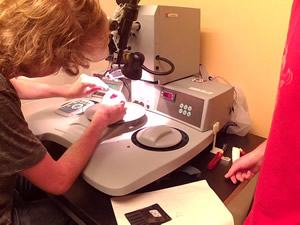
Gold-wire bonding at 3 a.m. in the morning with the homies.
While I didn’t have a going away party I did go out to dinner with Keshav and a few other members of the lab. We headed to an inexpensive conveyor sushi restaurant and purchased several rounds of dishes. In a way this was better than any party as I had time to really relax in a public and informal setting with my lab mates before departing. I went to almost every lab member and thanked them one by one including the lab secretary, Yumi-san. I also had the opportunity to give presents to my two closest lab members, Jinjing and Skylar and meet with Keshav one on one to discuss my work and more.
Speaking of my work, I believe I closed out my research project on a positive note. I was able to complete the initial goal of the project, which was to protect the optical properties of 2D phosphane. Unfortunately, I was unable to accomplish the more ambitious and exciting aspects of the project that came up later on in my internship. Despite this, a few interesting ideas for the future resulted from my work. The week that I was leaving I was attempting to make samples to test these ideas. I was also able to talk with a post-doc about the potential next steps of the project and we talked about remaining in contact to pursue the project further. While I don’t have the means to continue the more interesting aspects of this research project back at NJIT, this experience has definitely interested me in pursuing research in optics and 2D materials. I actually began talking with another intern in my lab (a graduate student who happened to be from a university less than 30 minutes away from me) and we discussed meeting up once he returns to NJ to possibly pursue a project revolving around a 2D material.
Now that I’ve finished the research however, I’m quite ready to relax. Therefore, for my final weekend I have one plan. Fuji-san.
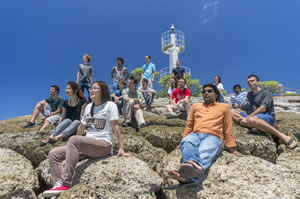
Yeah, we’re that cool.
FINAL RESEARCH PROJECT OVERVIEW
Protection of the Optical Properties of Few Layer 2D Phosphane ![]()
Dani Femtosecond Spectroscopy Unit, Keshav M. Dani.
Over the past year, the discovery and development of 2D black phosphorous (2D phosphane) has generated much excitement due to its high carrier mobility, strong anisotropy, and direct bandgap. 2D phosphane’s bandgap exhibits a significant layer dependency allowing for tunability from 0.3 eV (bulk) to 2 eV (monolayer), making it a versatile material for optical applications. The primary issue preventing the integration and development of 2D phosphane is the material’s ambient degradation. In the presence of light, water, and oxygen, black phosphorous undergoes a rapid photoassisted oxidation reaction resulting in the destruction of its electronic and optical properties. This project characterizes this ambient degradation by photoluminescence (PL) measurements and goes on to demonstrate an effective method of protecting the crystal’s optical properties with the use of thin layered hexagonal boron-nitride (h-BN). Using a method known as viscoelastic dry stamping, the few layer phosphane was placed onto a SiO2 substrate. Subsequently, thin layer h-BN (1-5 nm) was positioned on top to form what we termed a h-BN/BP heterostructure. We demonstrated the protection to be effective for 24+ hrs by using photoluminescence measurements. After this time period, an apparent blue shift of the PL signal accompanied by decreasing PL intensity indicates some form of degradation was occurring. To combat this, future studies should explore double capping of h-BN, XPS analysis of the degradation, and optimization of the PL excitation laser to prevent the overheating and degradation of the BP crystal. This project paves the way for the future use of 2D phosphane in a variety of different optical applications and devices.
It goes without saying that Japan has an immense amount to offer to all. Thanks to the NanoJapan program, I was able to experience a large and diverse portion of Japan. Simply put, I learned three important things from NanoJapan: how interesting Japan and its people are, how much fun research can be, and how much the rest of the world has to offer.
First, I can’t stress enough how rewarding and enjoyable it was to explore Japan and really get to meet and befriend its people. The NanoJapan Program really fostered the integration of its IREU students with Japanese college students, researchers, and teachers. What I mean by this is that the program purposely puts its students in situations where they are forced to interact with and get to know a variety of Japanese individuals. For example, due to the programs connection with KIP, a Japanese program encouraging the professional development of Japanese college students, we were able to build strong relationships with Japanese people our age. The program provided a perfect blend of structured and organized activities with the Japanese students while also giving us the freedom to hang out with them on our own. This in turn led to many nights out, friendly conversations, and opportunities to ask challenging and culture centered questions. In totality, it really afforded us the opportunity to make many good friends. I can still recall waking up at around 5 a.m. in the morning in the mountain woods of Nagano and taking an early morning walk with a Japanese student. As we walked down the mountain we talked about everything from suicide in Japan to gun rights in the United States. I won’t forget it. I wrote in depth about this sort of engagement in my week 4 report, but I think it’s worth being echoed. There’s nothing that can substitute for making friends across cultures. The experiences that went into that process provided me with a raw, genuine exposure to the people of Japan.
Second, this program has really broadened my view of what research looks like and what fields I’m interested in. Before I departed for Japan, I was reading a few student profiles and came across that of a past student whose name I can no longer recall. Regardless, this student talked about how she had spent her past two years working in labs and doing work that she didn’t necessarily enjoy and instead found demanding, stressful, and unrewarding. I related to this. While I had great opportunities to do work in the past, I never was doing work with which I was earnestly looking forward to go into the lab and do each day. NanoJapan and Professors Keshav’s lab changed that for me. The program put me in a laboratory and exposed me to a field of research I never knew existed. I was given hands on experience with aligning optics systems and working with and fabricating novel structures. I was able to taste the freedom independent research entails for myself. The partnership that NanoJapan has with Japanese universities is nothing short of incredible. The students participating in NanoJapan were placed in and able to work in literally the best laboratories in Japan. I was and (still slightly am) astonished at OIST, its people, and its facilities. This is a university that is truly doing something new and has the finances and right people (Nobel Laureates included) to lead it. I’m sure my fellow NanoJapan students could also tell of the impressive work taking place at their respective Japanese labs.
Finally, NanoJapan allowed me to understand something that, had I not participated in this program, I likely would not have understood until much, much later in life: just how much the world really has to offer. It’s a bit hard to explain, but before leaving for Japan I didn’t really think about the rest of the world. Sure, I would read about world events online or talk a bit about something that took place somewhere foreign, but I didn’t really think about the rest of the world. I didn’t think about how nations have such rich, rich cultures. Or how people from all over the world are really quite different from me and what that entails. I’m not talking about the semi-superficial differences we encounter here in the United States. I’m talking “so far removed that you didn’t even know that position on a topic or that type of behavior existed” different. It’s incredible. NanoJapan has provided me a glimpse of what international and cross-cultural differences really look like and let me tell you-it’s so, so cool to see it first-hand.
If a professor were to ask me about NanoJapan and what I learned I would first let him know that he unfortunately is too old to apply. However, he can live vicariously through me and my research exposure at OIST. Through the program I learned an immense amount about what my research interests are. I’m certain I did not have a concrete idea of what I enjoyed (only what I didn’t enjoy) before arriving. Now, I absolutely have a few solid interests I want to further explore. After arriving back home, I modified my course schedule to register for classes related to the work I did at OIST. At the Femtosecond Spectroscopy Unit I worked primarily with optics and 2D materials. I gained exposure far beyond that of what I expected. I not only had the opportunity to handle and exfoliate the newest Van Der Waals crystals, I was able to go ahead and combine various crystals to fabricate various Van Der Waals heterostructures and perform characterization using Raman and Photoluminescence measurements. Best of all, I was able to do so fairly independently. I didn’t have to wait for a post doc or graduate researcher to give me permission to do this or that like back at home. Instead, I given the freedom to go ahead and complete task A with the tools X,Y, and Z...it just so happened that the tools were very expensive. Additionally, if needed I could modify those tools, such as the Raman system, to fit the needs of whatever measurements I needed to make that day. NanoJapan really seems to act as a mechanism for greatly developing the research skills, independence, and knowledge of a young researcher.
If an employer were to ask me about what my NanoJapan experience taught me I would bring up two things. First, I would echo my prior statement on independence. Doing work without having to heavily rely on older researchers is a blessing. It teaches you an immense amount about how a job operates, how to complete a job, and how to do so efficiently and effectively. Second, it taught me how to better handle international collaboration and basic interaction. While I’m not arguing that I’ve mastered either of these two things, I think by working in an international laboratory and having the daily life exposure, I became better acquainted with how a situation may play out and how to respond. The minor car accident from Week 5 is an example. While the situation didn’t play out the smoothest, by experiencing it and looking back I can better see what steps I might have taken to correct the situation.
To all the students back at NJIT I have one word of advice about the NanoJapan program: apply. It really is incredible; and if you’ve never traveled abroad like me, it’s life-changing. While our school really encourages students to study abroad, many don’t make use of it or can’t due to financial reasons. NanoJapan gives students the opportunity to experience international exploration. A generous stipend is given and you are provided with an array of people to help you make the most out of your time in Japan. Unlike other international programs, NanoJapan provides its students with people like Keiko Packard. These sorts of people will come up alongside you as you participate in the program and take you to fascinating places, eat with you, introduce you to Japanese students your age, and immerse you in the land. It’s so well structured that it will most likely be unlike anything you have ever experienced. You have been warned. Do it!
As a result of the NanoJapan program I’ve already began to alter my academic outlook. As mentioned earlier, I’ve begun by changing my courses for the upcoming semester to reflect the work I did in Japan. I’ve switched out a math course and opted to take a hands-on optics course. This way, I can focus on something I really enjoyed and learn if perhaps it is what I should pursue beyond my four years at NJIT. I’m also looking to work in a lab that focuses on 2D materials. While my home university doesn’t have anyone specializing in this field, while in Japan I learned about a local university that has a well-known group. I’m considering contacting them and figuring out more about what I can pursue.
As far as language goes however I’m not pursuing anything. I have the language books and may do some self-studying, but I doubt I will go so far as to try and take a course at a local community college. While the language is interesting, I don’t really have a practical use for pursuing it right now.
One final thing that I’m looking to do is study abroad for a semester. My university has connections with many foreign universities, including several Japanese universities through the G3 engineering program. I’m now looking into applying for different scholarships so that I can actually afford to do so.
I would like to thank all the people involved in this program so very much. To Sarah Philips, thank you for the many emails concerning students activities and issues in Japan, countless emails from me that you read and responded to in depth, and effort you put into organizing much of this program (sorry for the many late emails!). To Dr. Cheryl Matherly, thank you for responding to the weekly reports and leading so much of the different sessions concerning the program. Dr. Kono, thank you for working with all of our labs to ensure our research experiences were insightful and enjoyable (thanks for OIST!). To Dr. Keshav, thank you again for giving me the incredible chance to work in your unit and learn so much. To Jingjing and Sklyar, thanks for both aiding me in my work. Numerous times I was able to ask either of you questions and you absolutely and without hesitation helped me. To the rest of my labmates I also would like to extend thanks. You all made my experience in Japan something I will never forget for the rest of my life.
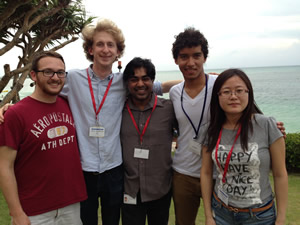
Dylan with Prof. Keshav Dani and his fellow summer interns in the Femtosecond Spectroscoy Group including NanoJapan 2014 alumnus Skylar Dekchoff-Jones.
Finally, to my NanoJapan mates, thank you. You guys made the program a blast. It was a once in a lifetime experience and I’m more than glad I got to share it with y’all.